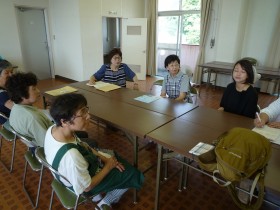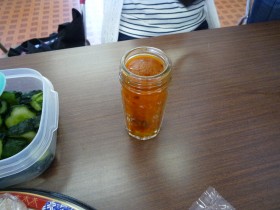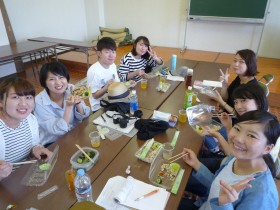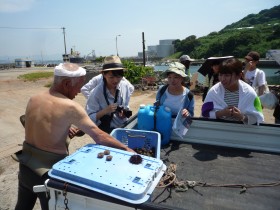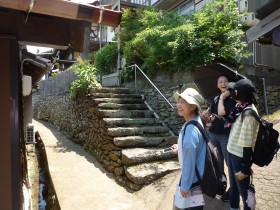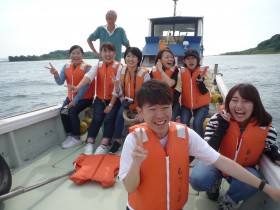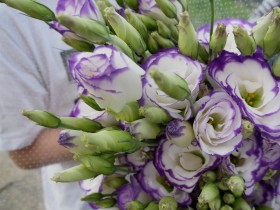- Home
- Circle "Japan Heritage Exploration Q" conducted a fourth fieldwork survey on Rokuren Island in Shimonoseki City for the completion of the "Rokuren Island Map".
Shimonoseki City University
TOPICS
Topics
#GeneralCircle "Japan Heritage Exploration Q" conducted a fourth fieldwork survey on Rokuren Island in Shimonoseki City for the completion of the "Rokuren Island Map".
On June 25, 2018 (Monday), seven members of the Japan Heritage Q Q Committee and one faculty member of the university conducted the fourth fieldwork as a final survey for the creation of the "Rokuren Island Map" on Rokuren Island, where one of the cultural properties of the Japanese heritage "Kanmon nostalgic Strait"-the stop of time and memories of modernization-" is located. Rokuren Island is famous for its cultivation of flowers, but this time we also surveyed food culture, including food processing. It was just the time of sea urchin fishing, and we had a tour of the bottling process and actually sampled the regional cuisine.
In the morning survey, the chairman of the self-government also worked hard this time, and we conducted a hearing survey again with six women's associations who heard the story last June 3, and 70% of the "Rokurenjima Map" was completed. I was able to supplement the shortage and insufficient points. In addition, one group of the circle asked the women's association to submit a questionnaire survey form on "Life, Events and Work on the Island", which was previously entrusted to the women's association. Valuable information and topics were written there, so I would like to organize and analyze it firmly and refer to it extensively.
For lunch, we served "Hijiki rice" from regional cuisine, an island with pickles of takuan and cucumber as a lunch box, and we were able to taste the alcohol pickling of sea urchin, a specialty product of the island, with Rokuren Island. The students were happy to enjoy it. The impression of "adult" is "just for sake!" That's right.
In the afternoon survey, while the fisherman in his 70s showed the fresh “bahununi” that had just been caught in underwater fishing, the catch of sea urchins decreased due to the effects of sea urchin fishing and global warming. I was told that. For the island, who has been taken care of many times in the past surveys, we will observe the work of carefully removing fresh sea urchins in cooperation with the third generation of the family, and directly learn a part of making labor-consuming processed products. I was able to learn. In addition, thanks to that person, I was able to get on a fishing boat and go around the island, and see the multifaceted scenery of Rokuren Island from the sea, including the back side of Rokuren Island, so I discovered the charm of a new island I was able to do it.
This time, on the way back, I also received a souvenir of cut eustoma and kato flowers, vegetables, special abalone for household consumption, and alcohol pickles of sea urchins containing sea turtles. Thank you very much.
In the future, the circle will reorganize and reconsider what the people of Rokurenjima have taught through interviews and questionnaire surveys so far, and what they have examined in the literature and materials by themselves, and around mid-July We will work toward the completion of the "Rokurenjima Map". Also, a little further away, I hope that we can help with some kind of community development at events such as the tour of the Rokurenjima Lighthouse scheduled for November 3.
For more information, please visit the website of the Japan Heritage Exploration Q Society (https://shidai-nikkyu.amebaownd.com/).
(Professor Department of Public Management, MIZUTANI Riaki)
- Listen to the women's association
- "Hijiki Rice,"
- The exquisite sea urchin pickled with alcohol and cucumber pickles are also available.
- I'm happy to have a delicious lunch, etc.
- Freshly caught "bahununi" etc.
- Walking around Shimauchi
- A fishing boat rides around Rokuren Island
- Special product flower, eustoma
- A special flower, Katou








